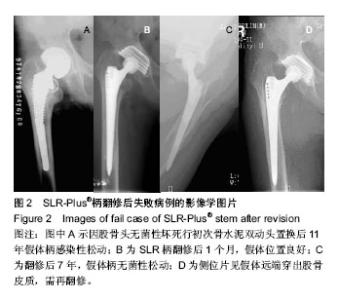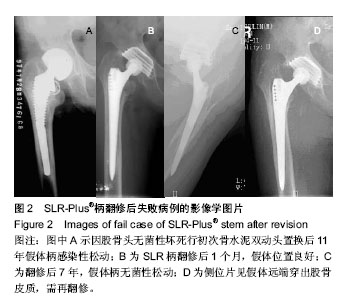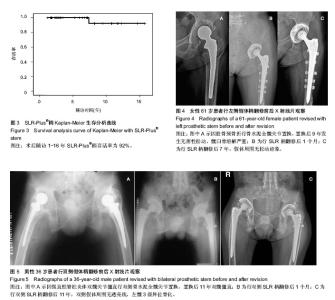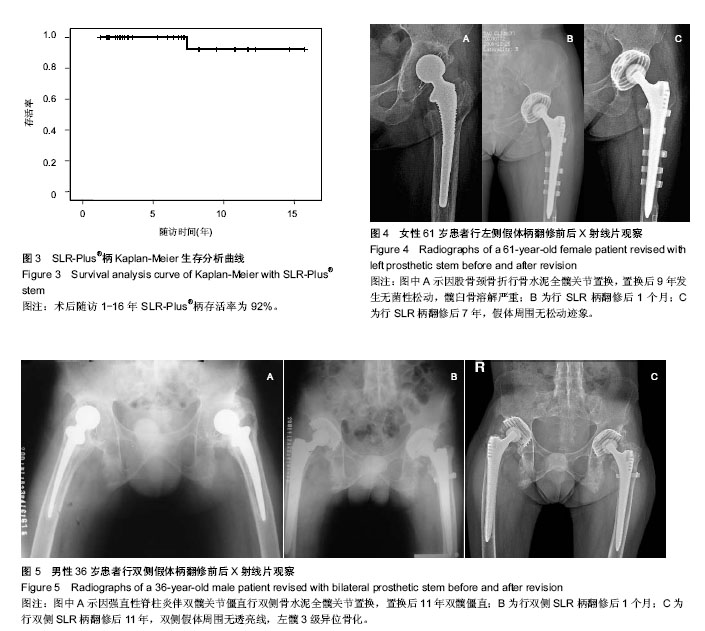| [1] Harkess JW. Arthroplasty of Hip: Revision of total hip arthroplasty. In Campbell’s Operative Orthopaedics. Ninth edition, St.Louis, Mosby Inc., 1998.
[2] Hunter GA, Welsh RP, Camerson HU, et al. The results of revision of total hip arthroplasty. J Bone Joint Surg. 1979, 61:419-423.
[3] Amstutz HC, Ma SM, Jinnah RH, et al. Revision of aseptic loose total hip arthroplasties. Clin Orthop Relat Res. 2004; 420:2–9.
[4] Katz RP, Callaghan JJ, Sullivan PM, et al. Long-term results of revision total hip arthroplasty with improved cementing technique. J Bone Joint Surg Br. 1997;79:322-326.
[5] Maurer SG, Baitner AC, Di Cesare PE. Reconstruction of the failed femoral component and proximal femoral bone loss in revision hip surgery. J Am Acad Orthop Surg. 2000;8:354-363.
[6] Labek G, Kovac S, Levasic V,et al. The outcome of the cementless tapered SL-Plus stem: an analysis of arthroplasty register data. Int Orthop. 2012;36(6):1149-1154.
[7] Zweymüller KA, Schwarzinger UM, Steindl MS. Radiolucent lines and osteolysis along tapered straight cementless titanium hip stems: a comparison of 6-year and 10-year follow-up results in 95 patients. Acta Orthop. 2006; 77(6): 871-876.
[8] Gruen TA, McNeice GM, Amstutz HC. Modes of failure of cemented stem-type femoral components. Clin Orthop. 1979;141:17-27.
[9] Brooker AF, Bowerman JW, Robinson RA, et al. Ectopic ossification following total hip replacement:incidence and a method of classification.J Bone Joint Surg (Am).1973; 55(8): 1629-32.
[10] Trumm BN, Callaghan JJ, George CA,et al. Minimum 20-Year Follow-Up Results of Revision Total Hip Arthroplasty With Improved Cementing Technique. J Arthroplasty. 2014;29(1): 236-241.
[11] Dohmae Y, Bechtold JE, Sherman RE, et al. Reduction in cement-bone interface shear strength between primary and revision arthroplasty. Clin Orthop.1988;236:214-220.
[12] Wieser K, Zingg P, Dora C.Trochanteric osteotomy in primary and revision total hip arthroplasty: risk factors for non- union.Arch Orthop Trauma Surg. 2012;132(5):711-717.
[13] 孙俊英,唐天驷,洪天禄,等.全髋关节股骨侧假体翻修术[J].中华骨科杂志,2001,21(6): 346-349.
[14] Neumann D,Dueckelmann L,Thaler C.Revision total hip arthroplasty using a cementless tapered revision stem in patients with a mean age of 82 years.Int Orthop. 2012; 36(5): 961-965.
[15] Chang JD, Kim TY, Rao MB, et al.Revision total hip arthroplasty using a tapered, press-fit cementless revision stem in elderly patients. J Arthroplasty. 2011;26(7):1045- 1049.
[16] Brown NM, Tetreault M, Cipriano CA,et al. Modular Tapered Implants for Severe Femoral Bone Loss in THA: Reliable Osseointegration but Frequent Complications. Clin Orthop Relat Res. 2014. [Epub ahead of print]
[17] Korovessis P, Repantis T. High medium-term survival of Zweymüller SLR-Plus® stem used in femoral revision.Clin Orthop Relat Res. 2009;467(8):2032-2040.
[18] St?drý V, Dungl P, Hajný P, et al. The Zweymuller endoprosthesis in hip joint revision surgery. Acta Chir Orthop Traumatol Cech. 2001,68(4):230-238.
[19] 康鹏德,裴福兴,沈彬.股骨大转子延长截骨在假体稳定股骨柄翻修中的应用[J].中华外科杂志,2009,47(3): 177-180.
[20] Zhu Z, Ding H, Shao H,et al. An in-vitro biomechanical study of different fixation techniques for the extended trochanteric osteotomy in revision THA. J Orthop Surg Res. 2013 ,8:7.
[21] 祖启明,刘宪民,刘贵堂,等.组配式假体在Paprosky Ⅲ型股骨近端骨缺损翻修中的应用[J].中国矫形外科杂志,2008,16(16): 1204-1206.
[22] Lakstein D,Backstein D,Safir O.Revision total hip arthroplasty with a porous-coated modular stem: 5 to 10 years follow-up.Clin Orthop Relat Res. 2010;468(5):1310-1315.
[23] Schofer MD, Efe T, Heyse TJ, et al. Modular noncemented femoral stem system in revision total hip arthroplasty. Orthopade. 2010;39(2):209-216.
[24] Paprosky WG,Burnett RS.Extensively prorous-coated femoral stems in revision hip arthroplasty”rationale and results. Am J Orthop.2002;31(8):471-474.
[25] Malkani AL, Lewallen DG, Cabanela ME,et al. Femoral component revision using an uncemented, proximally coated, long-stem prosthesis. J Arthroplasty. 1996;11:411-418.
[26] Woolson ST, Delaney TJ. Failure of a proximally porous-coated femoral prosthesis in revision total hip arthroplasty. J Arthroplasty. 1995;10 Suppl:S22-S28.
[27] Berry DJ. Femoral revision: distal fixation with fluted, tapered grit-blasted stems. J Arthroplasty. 2002;17(suppl 1):142-146.
[28] Regis D, Sandri A, Bonetti I, et al.Femoral revision with the Wagner tapered stem: a ten- to 15-year follow-up study. J Bone Joint Surg Br. 2011;93(10):1320-1326.
[29] Engh CA Jr, Hopper RH Jr, Engh CA Sr. Distal ingrowth components.Clin Orthop Relat Res. 2004;420:135-141.
[30] Walter WL, Walter WK, Zicat B. Clinical and radiographic assessment of a modular cementless ingrowth femoral stem system for revision hip arthroplasty. J Arthroplasty. 2006 ;21: 172-178.
[31] Weber M, Hempfing A, Orler R, et al. Femoral revision using the Wagner stem: results at 2–9 years. Int Orthop. 2002;26: 36-39.
[32] 周勇刚,肖逸鹏,王岩,等.二期翻修在人工髋关节置换术后感染治疗中的作用[J].中国矫形外科杂志,2007,15(11):808-810.
[33] Sergio R, David U, Emerson H. One-Stage Revision of Infected Total Hip Arthroplasty with Bone Graft. The Journal of Arthroplasty. 2008; 23(8):1165-1177.
[34] 寇伯龙,吕厚山,林剑浩,等.双锥面螺旋臼及加长矩型柄在髋关节翻修术中的应用[J].中华骨科杂志,2003,23(12):743-746.
[35] 孙永强,艾进伟,韩叶萍. Zweymüller系统在女性Crowe-III、IV型髋臼发育不良全髋置换术中的应用[J].中国矫形外科杂志,2008,16(23): 1764-1767.
[36] 魏宝刚. Zweymüller假体在髋关节发育不良成人期并骨性关节炎中的应用[D].内蒙古医学院, 2010.
[37] 周昭群. Zweymüller假体全髋关节置换治疗老年移位性股骨颈骨折临床疗效分析[J].中国医学创新,2013,10(6):122-123. |



